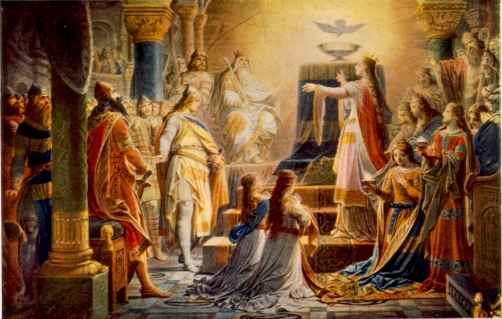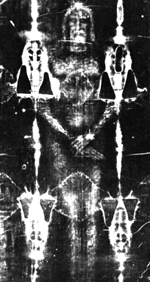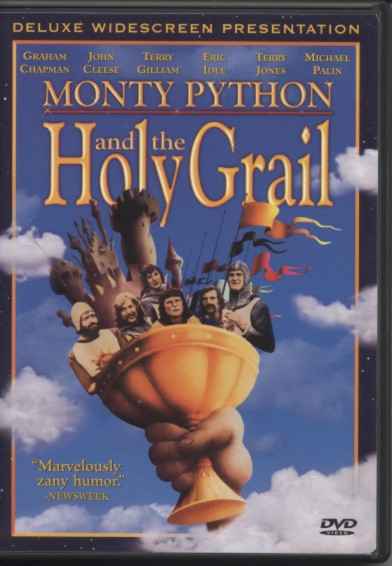|
Holy Grail The Holy Grail is just one of those things.
The Holy Grail is just one of those things. It's perhaps the most sought-after artifact in the history of the Christian era, except that no one is really quite sure what it is. The most popular notion is also the simplest, and most likely the wrongest too. According to legend, the cup Jesus Christ used at the Last Supper (when exhorting his apostles to vampirism) was saved by a certain Joseph of Arimathea. Joseph, for reasons incomprehensible to anyone but himself, used the cup to catch some stray blood dripping from Jesus during the Crucifixion. Subsequent to this, Joseph took off for parts unknown, where he eventually deposited this cup in a weirdly unreachable location for safekeeping... against whomever. This is a great story... Well, OK, it's an adequate story. The problem is that the tale didn't actually surface until about the 12th Century, when a flurry of so-called "Grail Romances" were penned, presumably based on some pre-existing oral tradition. Once it fully emerged as a cup, the Grail was variously described as a jewel-encrusted golden chalice of fabulous beauty. No one in the 12th century gave much thought to the odds of such a treasure being actually owned by a dirt-poor carpenter from Nazareth. The legend states that many knights and adventurers sought the cup, most notably Parsifal and King Arthur, who apparently wasted much of his reign sending all his best soldiers out in search of the Grail, where they encountered various plights and perils, some fatal.
The business of Relics had been booming for several centuries by the time the Grail stories began circulating, and people had been trading, selling, shilling and stealing just about any item that could be tenuously connected to Christ since about the 3rd Century. These included the spear that allegedly pierced Christ's side, the cross itself, the cloth of Veronica and, notably, the burial cloth of Jesus, a topic to which we shall return. Arguably, the Grail could simply have been one artifact that no one thought of at the time, notable only for its absence from the catalog of relics. It made for a good story. This theory would, of course, be far too simple. It's this kind of thinking that keeps the whole UFO thing under wraps. Luckily, intrepid researchers everywhere have come up with far more entertaining alternatives, which also happen to be marginally more credible than taking the stories at face value (please remember the word "marginally" as we proceed). By far the best and most controversial of these notions was laid out first in a controversial book, "Holy Blood, Holy Grail," which put forth an entirely different theory of the origins of the Grail legend.
From this jumping off point, the authors really went to town. They extensively researched the Knights Templar, a secret society related to Freemasonry, which was long rumored to be protecting some, let's say, "unusual" relics for questionable reasons. At various stages, the Grail legend became very specifically attached to the Templars. However, no Grail turned up when the French monarchy (in collusion with the Vatican) unleashed the Inquisition to exterminate the Templars and seize their treasures. According to HBHG, the Templars were actually an outgrowth of a previous secret society, the Priore de Sion, commissioned with protecting the greatest secret of Christianity that Jesus had fathered a child with Mary Magdalene, the first in a line of French warrior-kings. According to lore, Magdalene moved to the south of France to raise this child, who became father to the Merovingians, a medieval line of French royalty (historically extinguished, but the conspiracy theory holds that a single heir survives today thanks to the Priore de Sion). The Templars were based in the same region of France that legend associates with Magdalene, and in fact an annual festival still held there today venerates a human skull said to belong to the saint and former whore. This theory was expounded further by later authors, specifically books like "The Templar Revelation" and "The Jesus Conspiracy," which between them manage to create a surprisingly compelling case for the premise that the Shroud of Turin was one of the secret treasures of the Templars. The idea was further exploited by The DaVinci Code, although the author took substantial liberties in adapting the premise to fiction.
Under this theory, the Grail is actually the secret of the surviving bloodline of Jesus Christ, protected by the Templars with the assistance of the Church of Rome (which has an obvious interest in maintaining belief in the Resurrection). The Shroud itself was kept under wraps (and discredited through deception by the Church in modern times) because it offers something remarkably close to proof that Jesus didn't die on the cross. What's really surprising about these elaborate theories is how compelling they are. If you read the source material, you find that they require far less suspension of disbelief than theories about Area 51 or the Loch Ness Monster or even the Kennedy Assassinations. No discussion of the Grail legend would be complete without noting the most significant contribution to Western Civilization inspired by the Grail legend "Monty Python and the Holy Grail," which is right up there with "Citizen Kane" according to most well-informed media critics. With a cast list that includes parts like "2nd Soldier with a Keen Interest in Birds" and "Page Crushed By a Rabbit" and "Sir-Not-Appearing-In-This-Film," the movie successfully lampooned everything every written or thought about the Grail and/or King Arthur at the time and managed to get through the entire movie without ever actually showing any sort of Grail (except for one false alarm, which was actually a hoax perpetrated by eight-score nubile teenage girls in need of spankings). |
 All of these noble and romantic tales are, to use the term favored by historians and archaeologists, crap. Where did this notion come from?
All of these noble and romantic tales are, to use the term favored by historians and archaeologists, crap. Where did this notion come from?  Popular theory suggested the word grail itself came from a French or Medieval Latin term for "vessel" or "bowl." The authors of HBHG suggested that one version of the French term for "holy grail" "san greal" was a mistranslation of the phrase "sang real," which means Royal Blood.
Popular theory suggested the word grail itself came from a French or Medieval Latin term for "vessel" or "bowl." The authors of HBHG suggested that one version of the French term for "holy grail" "san greal" was a mistranslation of the phrase "sang real," which means Royal Blood.  The theory in its most complete form maintains that Jesus was rescued from the cross while still alive and medically treated with a cloth soaked in medicinal herbs of the day. The cloth was wrapped tightly around his body for some time, and the image of Jesus transferred to the cloth (the authors of the "Jesus Conspiracy" actually managed to replicate the image by recreating this technique, sans crucifixion).
The theory in its most complete form maintains that Jesus was rescued from the cross while still alive and medically treated with a cloth soaked in medicinal herbs of the day. The cloth was wrapped tightly around his body for some time, and the image of Jesus transferred to the cloth (the authors of the "Jesus Conspiracy" actually managed to replicate the image by recreating this technique, sans crucifixion).